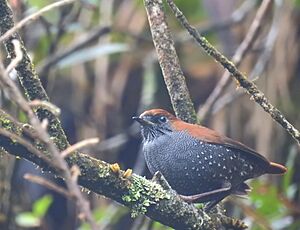Gould's shortwing facts for kids
Quick facts for kids Gould's shortwing |
|
|---|---|
 |
|
| Conservation status | |
| Scientific classification | |
| Genus: |
Heteroxenicus
|
| Species: |
stellatus
|
| Synonyms | |
|
Brachypteryx stellatus |
|
The Gould's shortwing (Heteroxenicus stellatus) is a small, star-spotted bird. It belongs to a group of birds called passerines, which are often known as "perching birds." This little bird is part of the Muscicapidae family, which includes Old World flycatchers and chats.
You can find Gould's shortwing in the high mountains of the Himalayas. This includes areas like Uttarakhand and Sikkim in India, and the country of Bhutan. It also lives in parts of Yunnan in China, and northern areas of Myanmar and Vietnam.
These birds like to breed in rocky places high up in the eastern Himalayas, above where trees can grow. When winter comes, they fly down to lower, warmer valleys that have more trees. Gould's shortwing is the only species in its special group, or genus, called Heteroxenicus. It used to be placed in a different genus called Brachypteryx.
The bird's common name, Gould's shortwing, honors a famous English bird expert and artist named John Gould. He lived from 1804 to 1881 and was well-known for his beautiful bird drawings.
Understanding Gould's Shortwing: Its Scientific Name and Family Tree
Scientists use a system called taxonomy to name and group all living things. This helps us understand how different species are related to each other.
The first time Gould's shortwing was officially described was in 1868. It was described by the English bird expert and artist John Gould. He studied a bird specimen that was found in Nepal. Gould gave it the scientific name Brachypteryx stellatus at that time.
Today, the Gould's shortwing is the only species in its own unique genus called Heteroxenicus. It was once thought to be part of the Brachypteryx genus. For a while, scientists even placed it in the thrush family, called Turdidae. The genus Heteroxenicus was first introduced by another scientist, Richard Bowdler Sharpe, in 1902.
The scientific name Heteroxenicus has a special meaning. It comes from old Greek words: heteros means "different," and xenikos means "stranger." So, it's like a "different stranger." The second part of its scientific name, stellata, comes from a Latin word, stellatus. This means "starry" or "set with stars," which fits the bird's spotted look!
There are two slightly different types of Gould's shortwing, called subspecies:
- H. s. stellatus (Gould, 1868) – This subspecies lives in the central Himalayas, stretching to southern China and northeastern Myanmar.
- H. s. fuscus (Delacour & Jabouille, 1930) – This subspecies is found in northwestern Vietnam.
What Does Gould's Shortwing Look Like?
The Gould's shortwing is a small bird, usually about 12 to 13 centimeters (about 5 inches) long. It weighs around 19 to 23 grams, which is about the same as a few quarters.
This bird has a beautiful chestnut-brown color on its back and wings. Its belly is dark grey, but it's covered with small white spots. These spots look a bit like tiny stars, which is why its scientific name means "starry"! It has long, brown legs and a black beak. Both male and female Gould's shortwings look very similar, so it can be hard to tell them apart just by looking.
Not much is known about where these birds build their nests or what their eggs look like. Scientists are still learning more about these secretive birds.


